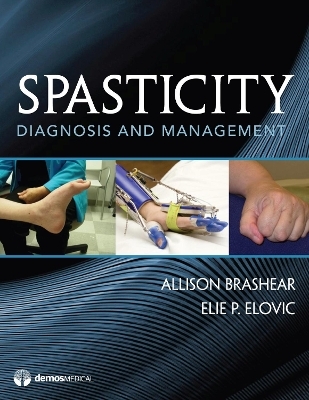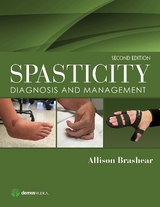
Spasticity
Demos Medical Publishing (Verlag)
978-1-933864-51-8 (ISBN)
- Titel erscheint in neuer Auflage
- Artikel merken
Spasticity: Diagnosis and Management is the first book solely dedicated to the diagnosis and treatment of Spasticity. This pioneering work defines spasticity in the broad context of Upper Motor Neuron Syndrome and focuses not on a single component, but on the entire constellation of conditions that make up the UMNS and often lead to disability.
Spasticity: Diagnosis and Management clearly defines the process for the diagnosis of Spasticity, the basic science behind its pathophysiology, the measurement tools used for evaluation and reviews the available treatment options. Divided into five sections, this comprehensive clinical resource provides a roadmap for assessing the complicated picture of Spasticity and choosing the appropriate interventions. Therapies including oral medications, intrathecal baclofen, botulinum toxin and phenol and surgical options are thoroughly discussed, as are non-medical therapies and the role of the emerging technologies. The full spectrum of diseases involving Spasticity in adults and children and the unique diagnostic and management challenges they present is addressed by experienced clinicians. This text is a one-stop source for Physicians, Therapists and other members of the Spasticity management team tasked with the goal of improving patient care and outcomes.
Special features of Spasticity: Diagnosis and Management include:
In-depth coverage of diagnoses, interventions and outcomes across multiple pathologies
Tools and clinical measurements for patient assessment
Treatment-focused chapters outlining current medical and other therapeutic options
Illustrated review of limb anatomy
Hands-on guidance to chemodenervation techniques with botulinum toxin and phenol and ITB management
Disease-based chapters devoted to the full range of clinical conditions involving Spasticity in adults and children
Multidisciplinary perspective supporting a team approach to care
Professor and Chair, Department of Neurology, Wake Forest University School of Medicine, Wake Forest Baptist Medical Center.||Professor and Chief, Division of Physical Medicine and Rehabilitation, University of Utah
Preface; I. General Overview: 1. Why Is Spasticity Important?, Allison Brashear and Elie Elovic, 2. Epidemiology of Spasticity in the Adult and Child, John R. McGuire; 3. Spasticity and Other Signs of the Upper Motor Neuron Syndrome, Nathaniel H. Mayer; 4. Ancillary Findings Associated with Spasticity, Cindy B. Ivanhoe; II. Assessment Tools: 5. Measurement Tools and Treatment Outcomes in Patients with Spasticity, Omar Gomez Medina and Elie Elovic; 6. Assessment of Spasticity in Upper Extremity, Thomas Watanabe; 7. Assessment of Spasticity in Lower Extremity, Alberto Esquenazi; 8. Setting Realistic and Meaningful Goals for Treatment, Elie Elovic; III. Treatment of Spasticity: 9. Chemoneurolysis with Phenol & Alcohol; Lawrence J. Horn, Gurtej Singh, and Edward R. Dabrowski; 10. Botulinum Toxin in the Treatment of Lower Limb Spasticity, Alberto Esquenazi; 11. Botulinum Toxin in the Treatment of Upper Limb Spasticity, Allison Brashear; 12. Anatomical Correlation of Common Patterns of Spasticity, M. Pathak and D. Truong; 13. The Role of Physical and Occupational Therapy in the Evaluation and Management of Spasticity Rob Shingleton, Jonathan H. Kinzinger, and Elie Elovic; 14. Emerging Technologies in the Management of Upper Motor Neuron Syndromes, Ira Rashbaum and Steven R. Flanagan; 15. Pharmacologic Management of Spasticity: Oral Medications, Jay M. Meythaler and Scott Kowalski; 16. Pharmacologic Management of Spasticity Utilizing Intrathecal Baclofen, Michael Saulino, Stuart A. Yablon, Elizabeth Moberg-Wolff, John W. Chow, and Dobrivoje S. Stokic; 17. Surgery in the Management of Spasticity, David A. Fuller; 18. Diagnostic Evaluation of Adult Patients with Spasticity, Geoffrey Sheean; IV. Evaluation and Management of Diseases Involving Spasticity: 19. Overview of Genetic Causes of Spasticity in Adults and Children; Donald McCorquordale and Stephan Züchner; 20. Spasticity Affecting Those with Neuromuscular Disease, Rachel M. Dolhun and Peter D. Donofrio; 21. Spasticity Due to Disease of the Spinal Cord: Pathophysiology, Epidemiology and Treatment, Heather W. Walker and Steven Kirshblum; 22. Spasticity Due To Multiple Sclerosis, Anjali Shah and Ian Maitin; 23. Spasticity Due to Stroke Pathophysiology, Anthony B. Ward and Surendra Bandi; 24. Spasticity in Traumatic Brain Injury, Ross Zafonte, Stephanie Co, and Anath Srikrishnan; 25. Evaluation and Non-surgical Treatment of the Child with Cerebral Palsy, Ann Tilton; 26. Surgical Management of Spasticity in the Child with Cerebral Palsy, Kat Kolaski, John Frino, and L. A. Koman; V. Basic Science of Spasticity: 27. Animal Models of Spasticity, Patrick Harvey Kitzman
| Erscheint lt. Verlag | 31.8.2010 |
|---|---|
| Verlagsort | New York, NY |
| Sprache | englisch |
| Themenwelt | Medizin / Pharmazie ► Medizinische Fachgebiete ► Neurologie |
| ISBN-10 | 1-933864-51-6 / 1933864516 |
| ISBN-13 | 978-1-933864-51-8 / 9781933864518 |
| Zustand | Neuware |
| Haben Sie eine Frage zum Produkt? |
aus dem Bereich



